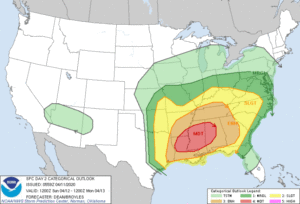This is a developing situation. Please monitor local TV and radio for local updates. We will update Saturday evening and Sunday morning:
The NWS and the NOAA Storm Center have been predicting a severe weather threat for this weekend for at least 72 hours. The severe event this weekend begins today in Texas and continues tomorrow across the South. Hee is what we know today:
- Severe storms with possible tornados will fire up this afternoon in Texas. San Antonio, Austin and Houston are under the gun.
- This system will come in waves. The first overnight and into the morning with heavy rains for many. The duration of these heavy rains will have a direct effect on the severity of storms for many. If they clear out quickly and the heat of the day is allowed to de-stabilize the atmosphere, then the severe threat increases.
- Tornados, flash flooding, high winds are the 3 main threats.
- New Orleans, Baton Rouge, Jackson, Birmingham are just some of the municipalities that are to be aware of the threat of long tracking tornados. Especially with the second wave expected Easter afternoon
- A 3rd wave is expected overnight into early morning.
- 2″-6″ of rain are expected in 24 hours across many areas including Alabama, Tennessee, and Georgia.
The official Saturday morning statement from the NWS and Storm Prediction Center:
Day 2 Convective Outlook NWS Storm Prediction Center Norman OK 1259 AM CDT Sat Apr 11 2020 Valid 121200Z - 131200Z ...THERE IS A MODERATE RISK OF SEVERE THUNDERSTORMS FOR CENTRAL/NORTHERN LOUISIANA...SOUTHEAST ARKANSAS...MUCH OF MISSISSIPPI...WESTERN/CENTRAL ALABAMA...... ...SUMMARY... An outbreak of severe thunderstorms appears likely Sunday into Sunday night, with the greatest threat expected from Louisiana through much of the Southeast and Tennessee Valley. Strong tornadoes, potentially widespread damaging winds, and large hail are all possible. ...Synopsis... The ejecting shortwave trough initially over the southern High Plains on Sunday morning is forecast to move quickly eastward to the lower MS Valley by early evening, and then accelerate northeastward toward the Ohio Valley late Sunday night into Monday morning, as it becomes absorbed within an amplifying longwave trough that will encompass nearly all the CONUS by 12Z Monday. In conjunction with the ejecting trough, a broad surface low centered over the central/southern Plains on Sunday morning will move eastward to the mid-MS Valley by 00Z Monday, and then move northeastward and rapidly intensify into an intense cyclone over the lower Great Lakes by 12Z Monday. A warm front will surge northward ahead of the low across the lower MS Valley and Southeast, while a strong cold front will move southward through much of the Plains in the wake of the departing cyclone. ...East TX northeastward through much of the Southeast and TN Valley... One or more clusters of deep convection will likely be ongoing at 12Z Sunday morning somewhere over east TX and potentially into portions of the lower MS Valley. The intensity and areal extent of any such clusters remain uncertain, but ample shear and instability will favor a threat of hail and damaging wind with any organized convection at the start of the period. Some tornado threat will also be present Sunday morning with any semi-discrete storms that begin to interact with the richer low-level moisture in the vicinity of the warm front. As this convection spreads northeastward, intensification is possible into portions of the ArkLAMiss region, with an increasing tornado threat in late morning/early afternoon with any surface-based storms, given rapidly increasing low-level moisture and shear. North of the warm front, evolution into a QLCS will be possible, with a corresponding risk of damaging wind into portions of the TN Valley. Meanwhile, further south, moderate to locally strong instability is forecast to develop along/south of the warm frontal position, which will be modulated by the impact of outflow from any early convection described above. Midlevel flow will increase to 70-100 kt as a south-southwesterly low-level jet intensifies into the 40-60 kt range. These wind profiles combined with ample instability (MLCAPE of 1500-3000 J/kg) will support the potential for intense supercells. Any surface-based initiation along and east of a pseudo-dryline moving into western LA by late afternoon could evolve into one or more long-tracked supercells capable of producing strong tornadoes, large hail, and damaging wind gusts. The extent of development within the warm sector remains somewhat uncertain, given the presence of a capping inversion and generally subtle foci for initiation. While the conditional risk of all severe hazards will be quite high if supercells develop, uncertainty remains regarding how convection will evolve from the morning into the afternoon. Any remnant outflow related to early convection will determine the northern extent of the higher-end tornado potential, and some guidance suggests the potential for elevated convection within a midlevel moist plume across the warm sector during the afternoon, which could either dampen the severe potential, or evolve into surface-based convection with a substantial severe threat. Given these factors, there is too much uncertainty to upgrade the ongoing outlook at this time. Evolution into more of QLCS is suggested by most guidance by Sunday evening, which would pose an increasing threat of widespread damaging winds and a few tornadoes across much of AL into western/central GA through the overnight hours. Higher wind probabilities may be needed in subsequent outlooks if confidence in this scenario grows. ...Central/southern Plains into the Ozark Plateau... While widespread convection to the southeast will likely limit transport of deeper Gulf moisture into the Plains/Ozarks, more modest moisture that was advected into the region on Saturday should remain in place ahead the advancing surface low and cold front Sunday afternoon. Steep lapse rates and cold midlevel temperatures associated with the primary shortwave will support moderate destabilization. Wind profiles will likely not favor classic supercells, with some backing of mid/upper-level flow expected, but effective shear will be supportive of organized structures. Large hail (potentially significant) will be the primary threat, with some wind potential if any upscale growth occurs. Wind profiles will not generally favor tornado potential, though robust updrafts interacting with locally enhanced vorticity near the surface cyclone could produce a tornado or two. ...TN Valley into the OH Valley -- Sunday night... Substantial uncertainty remains regarding the potential for destabilization from northern portions of the TN Valley into the OH Valley, due to the potential for widespread convection to the south of this area. However, rapidly strengthening wind fields in advance of the deepening cyclone will support the potential for damaging wind and perhaps a tornado risk by Sunday evening should even modest destabilization occur, as strong convection attempts to move in from the southwest in tandem with the deepening cyclone. ... Eastern Georgia into the Carolinas/Mid Atlantic... Substantial low-level moistening is expected over eastern GA into the Carolinas/Mid Atlantic through the period. There is a nonzero risk of organized convection along/north of the warm front during the day into the evening, which would pose some risk of locally damaging wind or perhaps a tornado, but confidence in this scenario is low at this time. A more likely scenario is for widespread upstream convection to evolve into multiple clusters or a QLCS and move into this region sometime early Monday morning. Intense wind profiles will support a risk of widespread damaging wind and a few tornadoes, given sufficient instability. The magnitude and coverage of the severe threat in this region will be determined in part by how fast organized convection approaches from the west. If convection accelerates and arrives faster that current guidance would indicate, then there is less time for low-level moistening and destabilization, and the magnitude and northward-extent of the threat may be limited. If convection does not arrive until very late in the period, then a more substantial severe threat could evolve. If some of the slower guidance turns out to be accurate, then the primary severe threat in this region may not come until the D3/Monday period. Probabilities may need to be increased in this area once the details come into better focus.






